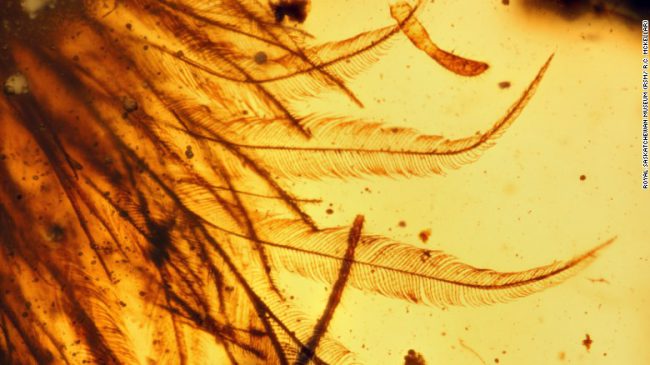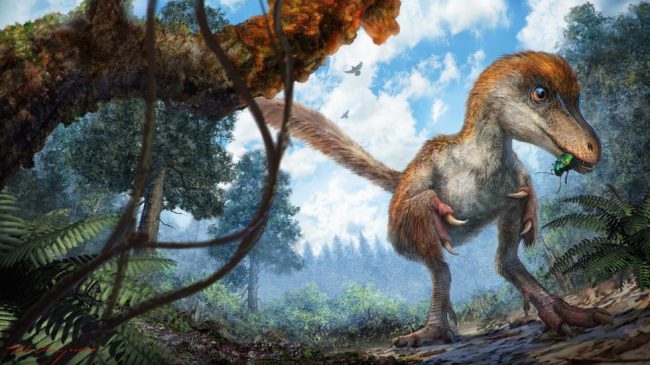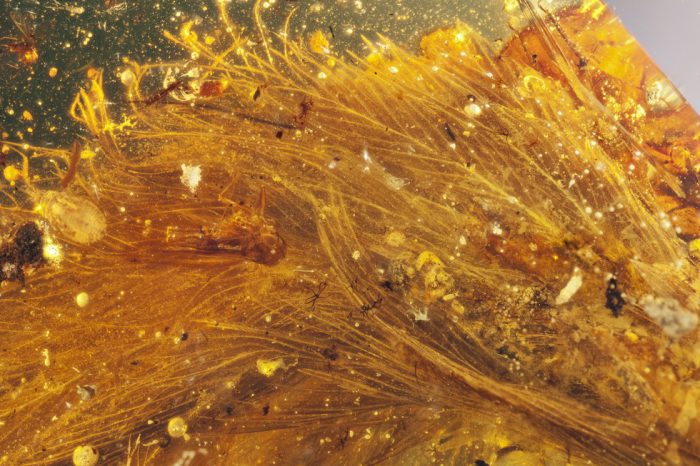To be good in the world of paleontology, you need hard work, patience, and a positive attitude. But then again, sometimes you just get lucky.
That's what happened to Xing Lida, a Chinese paleontologist. While Xing was hanging out at an amber market in the country of Myanmar, just south of China, he noticed something unusual in one piece of amber. Amber is hardened, fossilized tree resin. (Resin is similar to the scabs that we get on our body to help an injury heal.) It turns into a golden, rock-like substance that is often used as charms and jewelry. Because the tree resin is sticky and thick, it is normal to find things trapped inside, especially insects and other plants.
The trader thought the amber was full of remains of a plant. But Xing followed a hunch and bought it.
Turns out, he was more right than even he believed!
Confirmation of dino remains

This photo shows just how well-preserved the delicate feathers are. (Royal Saskatchewan Museum)
Xing was pretty sure just by looking at the amber that these weren't plants, but feathers. And theropod dinosaur feathers at that. (The theropods were a large, varied group of carnivorous dinos that included T rex, velociraptor, allosaurus, as well as other much smaller species.) But after he scanned the amber, he was blown away to discover that this fossil not only was full of dino feathers, it also contained parts of the animal's tissue, bones, and even dried blood!
How big a discovery was this? Dinosaur feathers have been found in amber before. Or at least, scientists are about 99% positive that they're dinosaur feathers. Because on their own, it's very difficult to say with complete certainty that they were actually on a dino. But this kind of fossil is that one-of-a-kind discovery that erases any doubt.
As Scott Person of the University of Alberta put it to the website, Seeker: "Per pound, it is the most incredible fossil I have ever seen, and it is as close to Jurassic Park as we have ever gotten." Person and Ryan McKellar of the Royal Saskatchewan Museum helped Xing process the fossil. All three of them are amazed by what he found.
What was it?

The remains of the dinosaur in this amber likely looked something like this maniraptoran. Today's birds are descended from this feisty fellow. (Chung-tat Cheung)
So what exactly was this retro reptile found in the amber? For starters, it wasn't a giant (or even velociraptor-sized for that matter). This dino belonged to a group of sparrow-sized animals called maniraptorans. The amber contains a section of the animal's tail, as well as some insects that were trapped as they fed on the dead dinosaur's remains. Because it is preserved in amber, the delicate features can be seen in three dimensions, too (instead of pressed flat like most fossils). It's almost like it's... alive.
Which brings us to the big question. After all, in the film and book Jurassic Park, dinosaurs are cloned and brought back to life using DNA found inside amber. So, maybe... ?
"Unfortunately, the Jurassic Park answer is still a 'no'," McKellar told CNN. It turns out that while some soft tissue and blood remains, all of the genetic material has long since decayed. (It was 99 million years ago that our little maniraptoran died!)
So no dinosaur theme park for us. Having seen the movies, that's probably a good thing! We'll stick with the amber, thanks!
 A closeup view of the dinosaur feathers trapped in amber. Can you find any of the insects trapped, too? (Royal Saskatchewan Museum)
A closeup view of the dinosaur feathers trapped in amber. Can you find any of the insects trapped, too? (Royal Saskatchewan Museum)










Awesome!
COOL! 😀 :-D.And those maniraptoran feathers in the amber!Waaaaaay past cool!